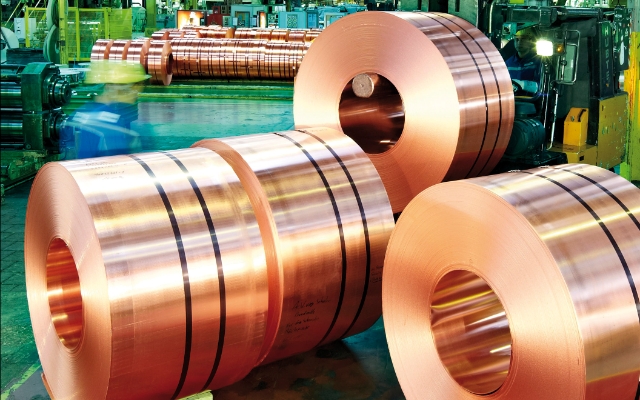Just How Copper Products Contribute to Sustainable Practices in Various Industries
Copper products are increasingly recognized for their substantial contributions to sustainable techniques across several markets, driven by their integral buildings such as effectiveness, recyclability, and sturdiness. In renewable resource systems, as an example, copper improves the capability of solar and wind innovations, while its application in building and construction lessens waste via durability. The material's antimicrobial features use encouraging advantages in medical care settings. As sectors seek to adopt even more sustainable techniques, the role of copper could confirm critical in accomplishing environmental goals. What effects might this have for future technologies in sustainability?
Copper in Renewable Energy
Copper plays a vital function in the development of renewable power modern technologies, acting as a crucial conductor in different applications. Its remarkable electric conductivity and resistance to corrosion make it an excellent product for electric wiring, which is crucial in photovoltaic panels, wind generators, and power storage systems. In solar photovoltaic systems, copper is utilized in the affiliations and circuitry, enabling reliable energy conversion from sunshine to electricity.
In wind power, copper is important to the generators and transformers that convert kinetic energy right into electrical power, ensuring ideal efficiency and reliability. The demand for electrical vehicles (EVs) is boosting, with copper being a key component in batteries, motors, and billing infrastructure. The shift to EVs considerably improves the need for copper, as these lorries generally utilize 4 times much more copper than traditional internal burning engine vehicles.
As the globe looks for to mitigate climate modification and transition to lasting energy sources, copper's function comes to be increasingly critical. The material not just enhances the performance and sturdiness of eco-friendly power systems yet additionally supports the wider objective of decreasing greenhouse gas discharges and advertising a sustainable future.
Eco-Friendly Building Products
In current years, there has actually been a remarkable change in the direction of the adoption of environment-friendly building materials in feedback to growing ecological issues. This change is encouraged by the need for lasting choices that reduce eco-friendly impacts while maintaining structural integrity and visual charm.
Copper, recognized for its resilience and recyclability, has emerged as a principal in this field. It can be made use of in roofing, plumbing, and electrical systems, adding to energy performance and reducing waste. Copper's longevity suggests fewer substitutes gradually, further enhancing its sustainability account.
In addition, materials such as bamboo, recovered timber, and recycled steel are getting popularity. These choices not only provide decreased ecological influence yet likewise advertise source preservation. As developing codes progressively emphasize sustainability, builders and architects are incorporating these products into their jobs, cultivating innovation in design.
The raising adoption of environment-friendly construction materials reflects a broader dedication to sustainability in the constructed atmosphere. By prioritizing these materials, the construction sector can considerably decrease its carbon impact, align with regulative criteria, and support a healthier ecosystem for future generations. This pattern notes a pivotal step in the direction of a much more lasting future in construction.
Copper's Function in Healthcare
Recent research studies have highlighted the significant duty of copper in medical care settings, particularly as a result of its antimicrobial homes. Copper surface areas have actually been shown to minimize the visibility of pathogens, including infections and germs, by approximately 99.9% within a brief duration. This exceptional efficiency makes copper an important material for high-touch surfaces in healthcare facilities, such as doorknobs, bed rails, and IV posts, thus adding to enhanced infection control measures.
In addition to its direct antimicrobial impacts, copper additionally contributes in the more comprehensive context of medical facility sustainability (Copper Products). By incorporating copper into clinical devices and home furnishings, healthcare centers can minimize the occurrence of healthcare-associated infections (HAIs), which not only improves person outcomes but additionally decreases the prices connected with extensive healthcare facility keeps and added treatments
Additionally, copper's durability and recyclability straighten with sustainable techniques, permitting responsible source monitoring. As medical care systems progressively focus on both client safety and security and environmental stewardship, the combination of copper products is ending up being much more common. This twin benefit highlights copper's essential payment to a much healthier, safer, and extra lasting medical care atmosphere.
Sustainability in Transport

Furthermore, copper's longevity and rust resistance add to the long life of transportation facilities (Copper Products). In rail systems, for example, copper elements improve the dependability and effectiveness of signaling and power systems, essential for lowering delays and energy intake. Additionally, copper's function in eco-friendly power systems, such as solar and wind, sustains lasting transportation solutions by giving clean energy for electric transit alternatives
Investments in copper innovation not just foster sustainability but also stimulate financial growth and task creation in green sectors. As sectors make every effort to fulfill rigorous environmental guidelines, the application of copper products in transportation arises resource as an essential method in accomplishing sustainability objectives and advertising a cleaner, more effective future.
Copper and Circular Economic Climate
As the world progressively accepts sustainability, the function of copper in the round economy becomes ever much more significant. Copper's inherent residential or commercial properties-- such as its recyclability, conductivity, and durability-- setting it as an essential material in a resource-efficient economy. The circular economy aims to lessen waste and take full advantage of resource use via recycling and reusing products, and copper master this regard.
The steel can be recycled forever without loss of top quality, making it an optimal candidate for lasting methods across numerous markets, including construction, electronics, and sustainable energy. By reprocessing and recuperating copper from end-of-life products, industries can significantly reduce the requirement for virgin products, consequently lowering environmental influences related to mining and handling.
Furthermore, the combination of copper into circular economic situation structures not only saves resources yet likewise fosters development. Companies that prioritize copper recycling contribute to an extra lasting supply chain, improving their competition while lining up with governing demands and customer choices for environmentally liable products.
Final Thought
In conclusion, copper items dramatically add to sustainable practices across multiple sectors. Their necessary duty in enhancing renewable resource technologies, promoting eco-friendly building and construction products, supporting infection control in health care, promoting sustainable transportation, and symbolizing the concepts of a round economy highlights the flexibility and value of copper. By incorporating copper into numerous applications, industries can accomplish higher effectiveness, decrease environmental impact, and line up with international sustainability goals, ultimately fostering a much more sustainable future.

Copper's excellent conductivity makes it a recommended material in electric car (EV) systems, improving power efficiency and efficiency. Furthermore, copper's role in sustainable energy systems, such as solar and wind, supports lasting transport services by supplying clean power for electrical transit alternatives.
Their important function in boosting eco-friendly energy innovations, promoting eco-friendly building products, supporting infection control in healthcare, helping with lasting transportation, and personifying the concepts of a circular economic climate highlights the convenience and websites value of copper.